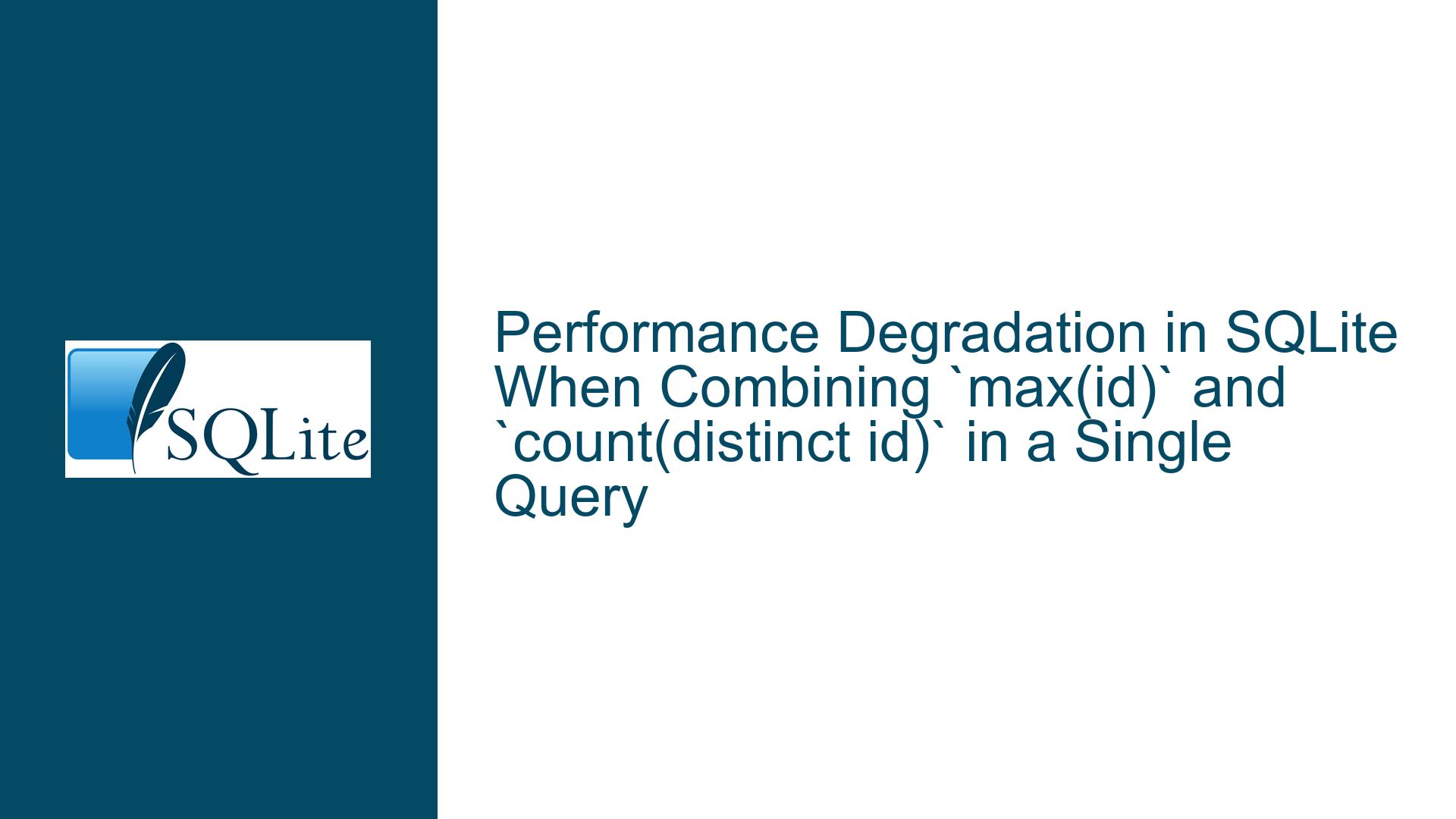Performance Degradation in SQLite When Combining `max(id)` and `count(distinct id)` in a Single Query
Understanding the Performance Impact of Combining Aggregate Functions in SQLite
When working with SQLite, combining aggregate functions like max(id) and count(distinct id) in a single query can lead to unexpected performance degradation. This issue arises due to the way SQLite’s query optimizer handles such queries, particularly when it involves creating temporary data structures like B-trees. Understanding the root cause of this behavior and how to mitigate it is crucial for optimizing database performance.
In the provided schema, the pro_comment table has an index on the id column (pro_comment_id), which should theoretically make operations like max(id) and count(distinct id) efficient. However, when these operations are combined into a single query, the execution time increases significantly. This behavior can be attributed to the optimizer’s decision-making process, which may not always choose the most efficient execution plan when multiple aggregate functions are involved.
To delve deeper into this issue, we need to examine the query execution plans, understand the optimizer’s limitations, and explore alternative approaches to achieve the same results without incurring the performance penalty. By dissecting the problem and exploring potential solutions, we can develop a strategy to handle similar scenarios effectively.
Why SQLite’s Optimizer Struggles with Combined Aggregate Queries
The core of the issue lies in how SQLite’s query optimizer processes queries involving multiple aggregate functions. When you execute a query like select max(id), count(distinct id) from pro_comment, the optimizer attempts to retrieve both results in a single pass over the data. However, this approach can lead to inefficiencies, particularly when the operations require different access patterns or temporary data structures.
For instance, the max(id) operation can be resolved efficiently by leveraging the existing index on the id column. Since the index is sorted, the maximum value can be found by simply accessing the last entry in the index. This operation is fast and requires minimal computational resources.
On the other hand, the count(distinct id) operation requires scanning the entire index to identify and count unique values. While this operation is more resource-intensive, it can still be performed efficiently using the existing index. However, when both operations are combined into a single query, the optimizer may decide to create a temporary B-tree to handle the count(distinct id) operation. This decision introduces additional overhead, as creating and populating a temporary B-tree requires significant computational resources and I/O operations.
The optimizer’s decision to use a temporary B-tree is influenced by its cost-based estimation process. In some cases, the optimizer may incorrectly estimate that creating a temporary B-tree is the most efficient approach, even though scanning the existing index would be faster. This misestimation can lead to the observed performance degradation.
Additionally, the optimizer’s ability to apply certain optimizations, such as the minmax optimization, is limited when multiple aggregate functions are combined in a single query. This limitation further exacerbates the performance issue, as the optimizer cannot fully leverage the available indexes to streamline the query execution.
Strategies to Optimize Queries Involving Multiple Aggregate Functions
To address the performance degradation observed when combining max(id) and count(distinct id) in a single query, we can employ several strategies. These strategies aim to minimize the optimizer’s reliance on temporary data structures and ensure that each aggregate function is executed as efficiently as possible.
One effective approach is to split the combined query into separate queries, each focusing on a single aggregate function. For example, instead of executing select max(id), count(distinct id) from pro_comment, we can execute the following queries separately:
select max(id) from pro_comment;
select count(distinct id) from pro_comment;
By separating the queries, we allow the optimizer to apply the most efficient execution plan for each operation. This approach eliminates the need for temporary B-trees and ensures that each query leverages the existing indexes optimally.
Another strategy is to use scalar subqueries to combine the results of separate queries into a single result set. For example:
select (select max(id) from pro_comment) as max_id,
(select count(distinct id) from pro_comment) as distinct_count;
This approach allows each subquery to be optimized independently, ensuring that the max(id) and count(distinct id) operations are executed efficiently. The results of the subqueries are then combined into a single result set, providing the same output as the original combined query but with significantly improved performance.
In cases where the use of temporary data structures is unavoidable, we can optimize the query by ensuring that the temporary B-tree is created and populated as efficiently as possible. This can be achieved by minimizing the amount of data processed during the creation of the temporary B-tree and ensuring that the necessary indexes are available to support the operation.
Finally, it is essential to monitor and analyze the query execution plans using tools like EXPLAIN and EXPLAIN QUERY PLAN. These tools provide valuable insights into how the optimizer is processing the queries and can help identify potential bottlenecks or inefficiencies. By understanding the execution plans, we can make informed decisions about how to optimize the queries and improve overall performance.
Detailed Troubleshooting Steps and Solutions
To effectively troubleshoot and resolve the performance degradation issue, follow these detailed steps:
Analyze Query Execution Plans: Use the
EXPLAIN QUERY PLANcommand to examine how SQLite is processing the queries. This will provide insights into whether the optimizer is creating temporary B-trees or leveraging existing indexes. For example:EXPLAIN QUERY PLAN select max(id), count(distinct id) from pro_comment;Review the output to identify any inefficiencies or unexpected operations, such as the creation of temporary B-trees.
Split Combined Queries: If the combined query is causing performance issues, split it into separate queries for each aggregate function. For example:
select max(id) from pro_comment; select count(distinct id) from pro_comment;This approach allows the optimizer to apply the most efficient execution plan for each operation.
Use Scalar Subqueries: Combine the results of separate queries using scalar subqueries. This approach ensures that each aggregate function is optimized independently. For example:
select (select max(id) from pro_comment) as max_id, (select count(distinct id) from pro_comment) as distinct_count;Optimize Index Usage: Ensure that the necessary indexes are available and being used efficiently. In the provided schema, the
pro_comment_idindex should be sufficient for bothmax(id)andcount(distinct id)operations. Verify that the optimizer is leveraging this index by reviewing the query execution plans.Monitor System Resources: Check for other processes that may be consuming CPU or I/O resources, as these can impact query performance. Use system monitoring tools to identify and address any resource contention issues.
Update SQLite Version: Ensure that you are using the latest version of SQLite, as newer versions may include optimizations and bug fixes that improve query performance. In the provided discussion, the user is using SQLite version 3.36.0. Consider upgrading to a more recent version if available.
Consider Database Design: Evaluate the database schema and design to ensure that it supports efficient query execution. For example, consider partitioning large tables or using materialized views to precompute aggregate results.
By following these steps, you can effectively troubleshoot and resolve the performance degradation issue when combining max(id) and count(distinct id) in a single query. Implementing these strategies will help optimize query performance and ensure that your SQLite database operates efficiently.
In conclusion, the performance degradation observed when combining max(id) and count(distinct id) in a single query is a result of SQLite’s query optimizer creating temporary data structures and struggling to apply certain optimizations. By understanding the underlying causes and employing strategies such as splitting queries, using scalar subqueries, and optimizing index usage, you can mitigate this issue and improve query performance. Regularly analyzing query execution plans and monitoring system resources will further enhance your ability to optimize SQLite queries and maintain efficient database operations.





